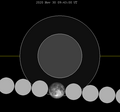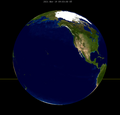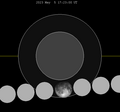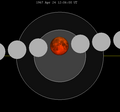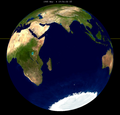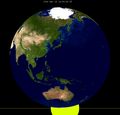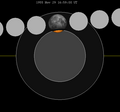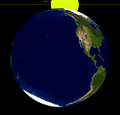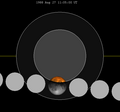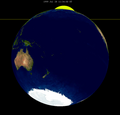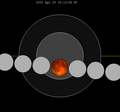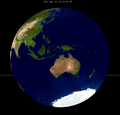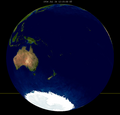Top Qs
Timeline
Chat
Perspective
May 2021 lunar eclipse
Total lunar eclipse of 26 May 2021 From Wikipedia, the free encyclopedia
Remove ads
A total lunar eclipse occurred at the Moon’s descending node of orbit on Wednesday, May 26, 2021,[1] with an umbral magnitude of 1.0112. A lunar eclipse occurs when the Moon moves into the Earth's shadow, causing the Moon to be darkened. A total lunar eclipse occurs when the Moon's near side entirely passes into the Earth's umbral shadow. Unlike a solar eclipse, which can only be viewed from a relatively small area of the world, a lunar eclipse may be viewed from anywhere on the night side of Earth. A total lunar eclipse can last up to nearly two hours, while a total solar eclipse lasts only a few minutes at any given place, because the Moon's shadow is smaller. Occurring only about 14 hours after perigee (on May 25, 2021, at 21:50 UTC), the Moon's apparent diameter was larger.[2]

It was the first total lunar eclipse since the January 2019 lunar eclipse, and the first in a series of an almost tetrad (with four consecutive total or deep partial lunar eclipses).[3] The next total eclipse occurred in May 2022. The event took place near lunar perigee; as a result, this supermoon was referred to in US media coverage as a "super flower blood moon",[Note 1][4][5] and elsewhere as a "super blood moon".[6][7]
This lunar eclipse was the first of an almost tetrad, with the others being on November 19, 2021 (partial); May 16, 2022 (total); and November 8, 2022 (total).
Remove ads
Visibility
The eclipse was completely visible over Australia and the central Pacific Ocean, seen rising over south and east Asia and setting over North and South America.[8]
  |
 Visibility map |
Timing
Summarize
Perspective
Local times are recomputed here for the time zones of the areas where the eclipse was visible:

The timing of total lunar eclipses are determined by its contacts:[9]
|
Remove ads
Gallery
- Garrett County, Maryland, 9:43 UTC
- Minneapolis, Minnesota, 10:19 UTC
- Berwick Forest, New Zealand, 10:52 UTC
- Taoyuan, Taiwan, 11:02 UTC
- Banyuwangi, Indonesia, 11:03 UTC
- Canberra, Australia, 11:11 UTC
- Manila, Philippines, 11:13 UTC
- Laguna, Philippines, 11:15 UTC
- Geelong, Victoria, 11:23 UTC
- Tarlac, Philippines, 11:32 UTC
- Kediri, Indonesia, 11:32 UTC
- Magetan, Indonesia, 11:34 UTC
- New South Wales, Australia, 12:01 UTC
- New South Wales, Australia, 12:21 UTC
- Chennai, India, 13:27 UTC
Eclipse details
Shown below is a table displaying details about this particular lunar eclipse. It describes various parameters pertaining to this eclipse.[10]
Remove ads
Eclipse season
This eclipse is part of an eclipse season, a period, roughly every six months, when eclipses occur. Only two (or occasionally three) eclipse seasons occur each year, and each season lasts about 35 days and repeats just short of six months (173 days) later; thus two full eclipse seasons always occur each year. Either two or three eclipses happen each eclipse season. In the sequence below, each eclipse is separated by a fortnight.
Remove ads
Related eclipses
Summarize
Perspective
Eclipses in 2021
- A total lunar eclipse on May 26.
- An annular solar eclipse on June 10.
- A partial lunar eclipse on November 19.
- A total solar eclipse on December 4.
Metonic
- Preceded by: Lunar eclipse of August 7, 2017
- Followed by: Lunar eclipse of March 14, 2025
Tzolkinex
- Preceded by: Lunar eclipse of April 15, 2014
- Followed by: Lunar eclipse of July 6, 2028
Half-Saros
- Preceded by: Solar eclipse of May 20, 2012
- Followed by: Solar eclipse of June 1, 2030
Tritos
- Preceded by: Lunar eclipse of June 26, 2010
- Followed by: Lunar eclipse of April 25, 2032
Lunar Saros 121
- Preceded by: Lunar eclipse of May 16, 2003
- Followed by: Lunar eclipse of June 6, 2039
Inex
- Preceded by: Lunar eclipse of June 15, 1992
- Followed by: Lunar eclipse of May 6, 2050
Triad
- Preceded by: Lunar eclipse of July 26, 1934
- Followed by: Lunar eclipse of March 27, 2108
Lunar eclipses of 2020–2023
This eclipse is a member of a semester series. An eclipse in a semester series of lunar eclipses repeats approximately every 177 days and 4 hours (a semester) at alternating nodes of the Moon's orbit.[11]
The penumbral lunar eclipses on January 10, 2020 and July 5, 2020 occur in the previous lunar year eclipse set.
Saros 121
This eclipse is a part of Saros series 121, repeating every 18 years, 11 days, and containing 82 events. The series started with a penumbral lunar eclipse on October 6, 1047. It contains partial eclipses from May 10, 1408 through July 3, 1498; total eclipses from July 13, 1516 through May 26, 2021; and a second set of partial eclipses from June 6, 2039 through August 11, 2147. The series ends at member 82 as a penumbral eclipse on March 18, 2508.
The longest duration of totality was produced by member 43 at 100 minutes, 29 seconds on October 18, 1660. All eclipses in this series occur at the Moon’s descending node of orbit.[12]
Eclipses are tabulated in three columns; every third eclipse in the same column is one exeligmos apart, so they all cast shadows over approximately the same parts of the Earth.
Tritos series
This eclipse is a part of a tritos cycle, repeating at alternating nodes every 135 synodic months (≈ 3986.63 days, or 11 years minus 1 month). Their appearance and longitude are irregular due to a lack of synchronization with the anomalistic month (period of perigee), but groupings of 3 tritos cycles (≈ 33 years minus 3 months) come close (≈ 434.044 anomalistic months), so eclipses are similar in these groupings.
Inex series
This eclipse is a part of the long period inex cycle, repeating at alternating nodes, every 358 synodic months (≈ 10,571.95 days, or 29 years minus 20 days). Their appearance and longitude are irregular due to a lack of synchronization with the anomalistic month (period of perigee). However, groupings of 3 inex cycles (≈ 87 years minus 2 months) comes close (≈ 1,151.02 anomalistic months), so eclipses are similar in these groupings.
Half-Saros cycle
A lunar eclipse will be preceded and followed by solar eclipses by 9 years and 5.5 days (a half saros).[14] This lunar eclipse is related to two annular solar eclipses of Solar Saros 128.
Remove ads
See also
Notes
- A full moon occurring in May has been termed a "Flower moon" in the US as recorded in the Old Farmer's Almanac.
References
Wikiwand - on
Seamless Wikipedia browsing. On steroids.
Remove ads
























